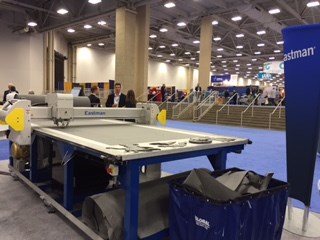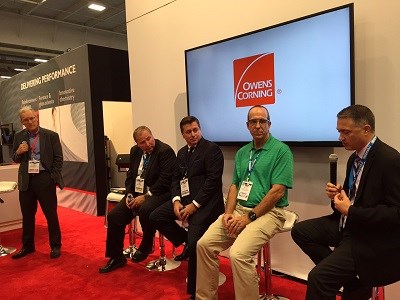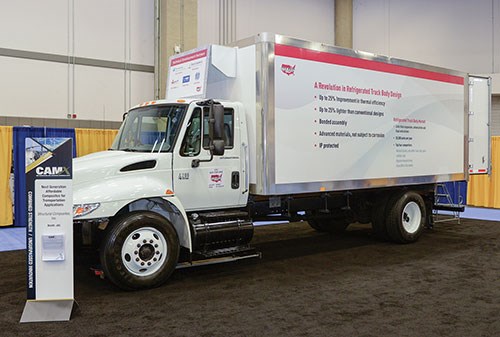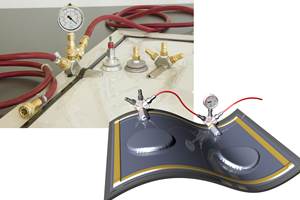CAMX 2015: More green, more customization, more growth
CAMX, the second year, was in interesting event, marked by a lot of enthusiasm, a lot of innovation and many new products.

This cutting table exhibited by Eastman Machine at CAMX was sold during the show.
CAMX, the second year, was an interesting event, marked by a lot of enthusiasm, a lot of innovation and many new products, more than I expected. The exhibit hall was busy, and having a third day of exhibits was an improvement over last year. Here’s an example of a healthy show floor: I ran into Shelly Barlow, operations manager for TCB Composite (West Haven, UT, US), whom we’ve written about in the past (http://www.compositesworld.com/articles/multi-material-rudder-trailing-edge-parts-replaced-in-single-stage-process). Barlow related that her company has outgrown their current space and is expanding, thanks to new contracts related to the A10 aircraft program. Because they’re doubling their equipment and capabilities, Barlow was walking the floor actually looking for equipment to buy. In addition to purchasing the Eastman Eagle S125 static cutting table on display (see photo), Barlow says she also finalized a second autoclave purchase and asked for quotes on filament winders and ovens that will be installed in the new expansion facility. She also talked to several companies about the purchase of an additional 5-axis milling machine, and two companies will be visiting TCB to quote on a dust collection system. Barlow says “I wish there were vendors for freezers, clean rooms and paint booths too. It was a productive show for us.” That’s the customer you want to see coming to the booth.
I was also struck by the presence of recently-formed companies who had never exhibited before. A standout was startup Carbon Flight (Sacramento, CA, US) who has a unique way to create hollow carbon fiber parts using a wax strand overwrapped with dry carbon fabric in a helical manner. After part cure, the wax is heated and removed, leaving engineered cavities with strong walls. Another new company, who found the CW booth and didn't exhibit, is Neuvokas (Ahmeek, MI, US), producing non-corroding basalt fiber-reinforced rebar reportedly on cost parity with steel rebar, which could represent a huge breakthrough.
And the technical papers and sessions offered a lot to chew on as well. Case in point: one of Tuesday morning’s first sessions included “The era of in-space manufacturing has begun,” Andrew Rush’ presentation in the Market Applications (Aerospace and Defense track) chaired by John Russell of the Air Force Research Laboratory. The former intellectual property lawyer, now president of startup firm Made in Space founded in 2010, described his firm’s philosophy: “People should be able to live and work better in space, since we may be colonizing new planets someday.” How would these explorers produce products or tools for themselves? By 3D printing, of course.
“A 3D printer is a meta-tool,” says Rush. “It’s capable of making other tools.” His argument is that if additive manufacturing (AM) could be a part of a launch mission, less “stuff” would have to be carried aloft during launch. And, he showed NASA statistics that 82% of part failures or breakdowns on the International Space Station (ISS) could have been repaired, had such capability been available. The company developed its own, robust, AM printer, since off-the-shelf 3D printers could not stand up to the rigors of microgravity.The unit was actually flown on a resupply rocket to the ISS in November 2014, and worked flawlessly, printing 21 objects with ABS plastic, among them a fully functional torque wrench needed by an astronaut. The machine and the parts returned to Earth, and those parts are currently being extensively tested to see what differences in properties, if any, might be present.
The company has improved and updated its AM machine, which can now print with three heads using three different materials. Looking further down the road, Rush says his group is literally thinking outside of the box, with concepts like units that could be launched into space and actually print satellites in the space environment — making structural parts such as beams or trusses with cached materials and components (possibly sent into space by other missions). A couple of issues that must be addressed is the lack of convective heat transfer to pull heat away from the parts as they’re made, because no atmosphere is present. And power draw is tricky, since all power must come from a solar array. A key point is that today, everyone, whether friend or foe, knows about payloads going into space. With this technology, payloads would be built as needed, on orbit. Concludes Rush, “We have two paradigm shifts happening: AM in microgravity, and in-space assembly and deployment.” The print file for the torque wrench is open and available online, and visit www.madeinspace.us for pictures and videos.

Owens Corning held an informal panel discussion on sustainability at the booth.
On Tuesday afternoon, Owens Corning (Toledo, OH, US) hosted an informal panel discussion at its booth, titled “Sustainability in the Composites Industry.” The panelists were senior executives from four prominent composites companies, all customers of Owens Corning, and the moderator was Owens Corning’s vice president and chief sustainability officer Frank O’Brien-Bernini. With many of Owens Corning’s top executives in attendance, including group president of composites solutions business Arnaud Genis, the panelists gave their views on sustainability as a business practice.
The executives on the panel included Sam Osten of Impact Guard (Leetsdale, PA, US), David Oakley of pultrusion firm Strongwell Corp. (Bristol, VA, US), Andy Flad of Composites One (Arlington Heights, IL, US) and Mike Siwajek, director of research and development at Continental Structural Plastics (Auburn Hills, , MI, US). Osten noted that European and Chinese fuel efficiency standards are higher than the US, and we’re having to catch up; Flad added that he feels his firm is “an advanced scout” for customers, in terms of learning about new regulations as well as sustainable practices and programs: “We’re seeing more carbon fiber recycling programs, and we’re also working with customers on converting products over to thermoplastics, which are more easily recycled.” Oakley pointed out the Strongwell is already heavily invested in sustainable practices, and that they see how important they are to many of their customers. Osten added that recycling of his firm’s thermoplastic sheet and panel products is occurring already, and that they’re starting to go “full circle” in reusing scrap and waste in their production.
When asked by O’Brien-Bernini about success in positioning composites against traditional materials based on sustainability and life cycle advantages, Flad answered that young engineers are using more composites, and they recognize the benefits. Siwajek added that there is a lot of room to do more in this area, and that the benefits need to be pointed out better to customers. With regard to the issue of recycling of thermoset composites, Flad said “There’s a social imperative today to recycle. There will be more money and research brought to this problem, but it’s not happening yet.” Siwajek agreed that young students are keen on recycling and waste reduction, and that “Young people think differently about this. We need to do more research and development in this area, because it’s the right thing to do. Many of our customers are demanding it – we have to make it work.” Osten added that by making parts that last longer, that’s green in itself, but “Collecting the waste and recycling it is still a hurdle.”
Composite One’s Flad believes that issues such as water shortages offer huge potential for composites, for reverse osmosis plants and alternative energy devices (e.g., wave energy generators). Strongwell’s Oakley pointed out that much of his company’s scrap is sold, not landfilled, which is a benefit, but sustainable practices “provide a reason for customers to want to buy our products.” All panelists agreed that scrap reduction and better, green practices at their facilities are necessary as a foundation for sustainability.
Owens Corning continued a sustainability theme in the technical sessions. Wednesday’s featured session in the Green and Sustainability track, titled “LCA for Composites and its Impact on Sustainability,” was presented by Dhruv Raina, senior manager product and supply chain sustainability at Owens Corning. Raina explained sustainability, through examples of customer products such as the new composite pallet produced by RM2 (Luxembourg and Woodbridge, Ontario, Canada). A life cycle analysis (LCA) conducted on the pallet, assuming 100,000 pallet trips and comparing composite to traditional wooden pallets, shows that the RM2 pallet is clearly a more sustainable choice with greater environmental benefits, when its entire useful life is examined, with a 50% lower impact based on energy demand and global warming potential. “People tend to believe ‘environmental folklore’ and most would think the wood is recyclable and therefore better,” says Raina. “How will it be used? What is the chain of impacts over the product’s life? All products have impacts, so we need to pick the product with the least impact.”
Raina presented some initiatives that OC is involved with, including a push toward more glass fiber-reinforced polymer (GFRP) rebar, with a collaborative industry group called Infravation (https://www.fhwa.dot.gov/research/resources/infravation.cfm). “Often, a concrete producer has to landfill millions of pounds of cement with too-high chloride content, which will cause steel rebar to rust. GFRP rebar is not affected by the chloride, and doesn’t require fresh water in the concrete mix either. Huge monetary savings could be realized with a composites approach,” he explains. He also cited a recent LCA done with Continental Structural Plastics (CSP, Auburn Hills, MI, US) comparing that company’s TCA Ultra Lite sheet molding compound (SMC) to aluminum and steel. The study showed SMC’s energy consumption is virtually the same as aluminum, and the composite uses less energy during production. SMC has the lowest global warming potential (GWP) of the three materials, which provides a sustainable storyline to support conversion to composites.
A key point in the presentation is that metals producers are not standing still, and are also introducing more sustainable practices. Alcoa just announced its “Micromill” concept, which would locate aluminum production adjacent to customer facilities (like Ford). A new produces reduces the time between melt to coil from 20 days to just 20 minutes, and will substantially reduce aluminum’s carbon dioxide footprint. The bottom line? New younger consumers are creating market forces that will drive more companies to sustainable practices, concludes Raina. “Better recyclability, collaboration with partners and more product transparency in regards to impacts will ultimately help your company sell more product.”

Wabash National unveiled its new refrigerated truck trailer concept developed with Structural Composites and other composites industry partners. It was a CAMX award nominee.
This year’s CAMX award nominees, sponsored by Ashland, were selected based on ability to grow composites’ market share. Although it didn’t win the award, “Next Generation Affordable Composites for Transportation Applications” by Structural Composites Inc. (Melbourne, FL, US), is already impacting the transportation market, with a breakthrough that brings composites close to cost parity with traditional designs. Structural Composites, through a broad collaborative effort that includes market insertion intermediary Composite Application Group (CAG, Oak Ridge, TN, US) and several material suppliers, has translated its innovative and cost-effective design work for the US Navy combatant craft into refrigerated truck trailers, which are now in production at Wabash National Corp. (Lafayette, IN, US). BASF was part of the collaboration, as was PPG and Interplastic.
Wabash went public on Monday, Oct. 26 with the announcement of their new composite refrigerated trailer line, one of which was on display in the CAMX awards area; the company also displayed the concept at the International Foodservice Distributors Assn. (IFDA) Distribution Solutions Conference in Phoenix the same week. But the technology behind the new product is fascinating. Structural Composites’ Scott Lewit, Wabash National’s structural engineering manager Andrzej Wylezinski, and Jeff Austad, national sales manager at Magnum Venus Products (MVP, Kent, WA, US) gave a paper Tuesday morning with some details.
Key to the technology is what Lewit calls CoCure Strain Tunable Resin. Low-cost, commodity polyester resin and gel coat can be mixed with polyurethane, with the polyurethane ranging from 15 to 20% by volume, to achieve higher elongation, toughness and better long-term performance. The resin mix can be varied spatially, across the part, or through the thickness of the part, to achieve customized results, says Lewit: “There’s no need to use the same resin throughout the entire part. You can tune the resin to fit the application, by adding just a bit of the more expensive PU resin to a lower-cost commodity material. This gets resin price under control.” To make this mixing possible, MVP is developing application machines with dual metering capability: polyester and catalyst on one side, and two-part polyurethane on the other, that come together at the spray head, says Austad. The mixture can be changed on the fly on the shop floor.
Panels for the roof, walls and floor of the trailers are composite sandwich designs, with Structural Composites’ Prisma preform frames between the skins; the interior space between skins is foam-filled for maximum insulation. Wylezinski adds that a big rig trailer environment is “highly stressed” and that the new design allows for much lighter weight, up to 25%, enabling higher payloads, while maintaining durability. It also provides 25% better thermal efficiency, and a much more durable product that can stand up to loading and unloading, and the road environment. “We liked that we could adjust not only the reinforcements, but also the resin properties as well,” he says. Wabash has opened a facility at its Lafayette plant to produce the new composite panels, and has plans to ramp up from the current limited production phase to full production within 18 months.

The large, black block in the foreground is a machinable carbon/PEEK billet for complex parts, made by Impact Composites.
There were lots of new products on display, and those will be written and presented in an upcoming issue of CW magazine. One example from thermoplastic specialist Impact Composites (Erlanger, KY, US) was a new molded woven carbon/polyetheretherketone (PEEK) solid billet, intended to be machined to net shape for complex, three-dimensional parts. Sean Reymond, the company’s chief technology officer, says the billet, called VTL (Very Thick Laminate), is a good alternative to replace titanium or aluminum parts, in orthopedic medical applications such as external fixation devices for broken bones or orthopedic tools (VTL is the large block on the table in the photo foreground). VTL can be produced to suit customer needs, in a variety of thicknesses and sizes. “Because it’s a thermoplastic resin, there’s no worry about exotherm during molding,” says Reymond. Reymond gave a technical paper on his technology during the show, and more information about Impact Composites can be found at www.impactcomposites.com.
Finally, one of the things that stuck with me from the Dallas trip was meeting Eddie Deen. CW held an event at a place called Eddie Deen’s Ranch, an event venue with great food and entertainment, and I was sipping a spicy margarita and talking to Andre Cocquyt when Deen walked up and introduced himself. At that point, I didn’t realize that Deen is a world-renowned barbeque caterer in the Dallas area, owns several restaurants, and maintains infrastructure that enables him to cater really big events, like gubernatorial state dinners in Texas and U.S. presidential events at which tens of thousands of people are served in as little as half an hour (here’s a link to an interview with Deen conducted by TexasMonthly magazine: http://www.tmbbq.com/interview-eddie-deen-of-eddie-deens-and-co/). But what he talked about was his work with disadvantaged youth and the homeless, and his theory that the brain can be changed, away from self-destructive behavior to positive, clear thinking. “I use the analogy of a horse. Do you want to be a trail horse, afraid of stepping off a trail and not able to lead, or a cutting horse, who is thinking and in control of the situation?” he told me. Many of the people working that night at the Ranch venue, from food servers to bar staff, were there as part of Deen’s youth programs at local high schools and homeless outreach, and were learning positive life skills through the catering experience. It was an eye-opening lesson on how small and medium businesses can really have an impact on their local communities, through training young people to take part in their economic growth.
Related Content
GKN Aerospace, Joby Aviation sign aerostructures agreement
GKN Aerospace will manufacture thermoplastic composite flight control surfaces for Joby’s all-electric, four-passenger, composites-intensive ride-sharing aircraft.
Read MoreSmartValves offer improvements over traditional vacuum bag ports
Developed to resolve tilting and close-off issues, SmartValves eliminate cutting through vacuum bags while offering reduced process time and maintenance.
Read MoreComposite resins price change report
CW’s running summary of resin price change announcements from major material suppliers that serve the composites manufacturing industry.
Read MoreCompPair adds swift prepreg line to HealTech Standard product family
The HealTech Standard product family from CompPair has been expanded with the addition of CS02, a swift prepreg line.
Read MoreRead Next
Plant tour: Daher Shap’in TechCenter and composites production plant, Saint-Aignan-de-Grandlieu, France
Co-located R&D and production advance OOA thermosets, thermoplastics, welding, recycling and digital technologies for faster processing and certification of lighter, more sustainable composites.
Read MoreVIDEO: High-volume processing for fiberglass components
Cannon Ergos, a company specializing in high-ton presses and equipment for composites fabrication and plastics processing, displayed automotive and industrial components at CAMX 2024.
Read More“Structured air” TPS safeguards composite structures
Powered by an 85% air/15% pure polyimide aerogel, Blueshift’s novel material system protects structures during transient thermal events from -200°C to beyond 2400°C for rockets, battery boxes and more.
Read More














.jpg;maxWidth=300;quality=90)







